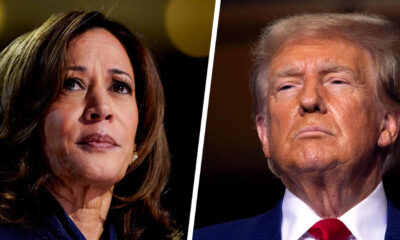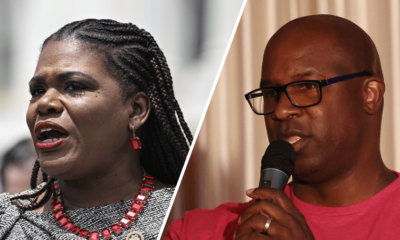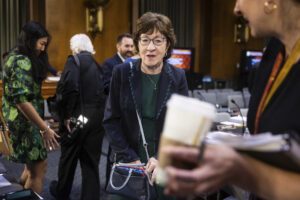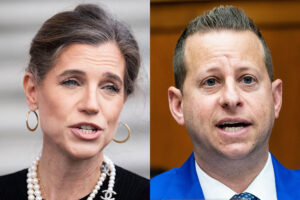Congress
Hakeem Jeffries’ redistricting crusade runs into resistance from fellow Democrats
Hakeem Jeffries is presenting himself as a hard-charging leader of his party, pushing a crash blue-state redistricting program to counter President Donald Trump’s moves to add Republican seats in Texas, Missouri and elsewhere.
But behind the scenes, the House minority leader is encountering the limits of his power — and the credibility of Democrats’ counterattack. Just this week, some Illinois lawmakers sent Jeffries a clear message they were not interested in pursuing a redraw that could dilute their districts with additional GOP votes. And in his home state of New York, state and party officials have all but rejected his suggestion they draw a new map, saying it’s not legally possible ahead of the midterms.
Jeffries privately met with members of the Illinois delegation on Tuesday to hear out their redistricting concerns, according to five people granted anonymity to share details of the discussion. Jeffries told them to keep all of their options open but acknowledged every Democratic member of the congressional delegation would need to buy in to a redraw before it could move forward, the people said.
After a post-2020 Census revision, only three of the state’s 17 congressional districts are represented by Republicans. But up to four Democratic incumbents could face tougher races if those GOP-held seats were made bluer, said Rep. Robin Kelly, a former chair of the Democratic Party of Illinois.
“We have to look out and protect who we have because we fought hard to get them in,” Kelly said in an interview. “I’m not a mapmaker, but it seems like it will be very difficult.”
“Everyone is talking about it,” she added, when asked if she had registered her concerns to Jeffries or Illinois Gov. JB Pritzker.
Some in the party believe that because four incumbent Illinois Democrats are exiting, including Kelly, there might be some wiggle room to redraw lines without undue disruption. But Rep. Lauren Underwood, who is seeking reelection in one of those potentially marginal districts, was blunt: “I don’t think redistricting is happening in Illinois,” she said. “Talking about it and it happening are two different things. We get on the ballot in six weeks.”
The internal pushback is the latest complication Jeffries faces in delivering the Democratic base a fight against Trump’s majority-protection play — and delivering himself the House gavel in the midterms.
Jeffries has worked to put himself at the forefront of the nationwide map fight, though his work has primarily played out behind the scenes through meetings with his members and calls to blue-state governors. He has publicly championed state Democrats’ resistance to the GOP redraw in Texas and privately discussed potential counterattacks with Pritzker and Maryland Gov. Wes Moore. He has tapped his donor network to help bankroll Gov. Gavin Newsom’s ballot measure that would enable a new map in California, where Democrats hope to add five more seats to offset potential GOP gains in Texas.
“Republicans were apparently operating under the misguided notion that we were going to let them get away with trying to rig the midterm elections without a forceful response. They were badly mistaken,” Jeffries told reporters last week. “At the end of the day, it’s not going to work out well for them.”
John Bisognano, president of the National Democratic Redistricting Committee, said Jeffries has been a “true leader” amid a “very dramatic process.”
“I think it’s been really difficult and a yeoman’s task to try and get members all on the same page when many of them have their own vested interests, but also many of them just genuinely need a deeper understanding of a very complicated topic,” he said.
But Jeffries is not Trump, a dominant leader who can snap his fingers and grind his intraparty critics into submission. The White House has mounted a maximalist pressure campaign, hauling reticent state Republicans to Washington and dispatching top aides and even Vice President JD Vance to strong-arm GOP governors and lawmakers.
Jeffries is in a much more precarious position. Just two-and-a-half years into his party’s top House leadership job, he still has to be mindful of the wishes of the lawmakers who elected him, even as a restless Democratic base pushes party leaders to fight Trump and Republicans on all fronts.
He has also been limited by legal guardrails Democrats put up in some blue states to restrict gerrymandering — laws that have now left the party at a disadvantage in what’s becoming a tit-for-tat war. Republican-controlled states will likely be able to draw more Democrats out of their seats than Democrats will be able to target GOP lawmakers in blue states.
That poses a threat to Jeffries’ aspirations of becoming speaker in 2027. Yet the New Yorker has stuck to his low-key, conciliatory leadership style, with Democrats pointing to the deference he’s given to the Democratic Congressional Campaign Committee, state congressional delegations and state-level officials in handling the process.
State legislative leaders in Illinois have been hesitant to embrace redistricting even as Pritzker told reporters he’s “pledged” to Jeffries “that I’ll do everything I can to make sure that Democrats win the Congress in 2026.” As of Thursday, Jeffries had not contacted the Illinois House or Senate leaders about proceeding. In Maryland, top Democrats have yet to make any significant moves. And not all in the party are comfortable with a scorched-earth redistricting strategy.
“They’re going low,” said Rep. Jonathan Jackson (D-Ill.) of Republicans. “We’ve got to fight — I agree with that — but it’s wrong. So two wrongs don’t make it right.” Jackson added he would support Democratic leaders’ ultimate decision on redistricting in Illinois.
In New York, Jeffries’ team failed to get immediate action from Democratic state lawmakers and Gov. Kathy Hochul to redraw House lines in time for next year’s elections. Jeffries and the governor were in contact, and Hochul in August embraced gerrymandering in response to Texas’ actions. But a quasi-independent commission and a prohibition against partisan redistricting has been enshrined by voters in the New York constitution. Any changes would require an amendment, which takes at least two years to finalize.
The efforts by Jeffries and his advisers frustrated New York Democrats, who had scant options to quickly redraw the state’s House map. It didn’t help matters that the Brooklyn Democrat’s team provided little guidance.
“Jeffries’ people were the main people pushing for it,” said a Democratic state legislative aide close to the process who was granted anonymity to speak frankly about internal discussions. “They were pushing Hochul with no real clear understanding of what to do.”
Jeffries’ push comes as he navigates far broader political headwinds. He’s being pummeled by progressives at home for not backing democratic socialist Zohran Mamdani in the New York City mayoral race, while facing pressure on Blue Light News to show whatever backbone the minority party can muster in the next big fight over government funding.
“He’s really kind of straddled both worlds here: He clearly, fully embraced this redistricting fight, while also being one of the holdouts in endorsing the Democratic nominee for mayor of the biggest city in his state,” said Andrew O’Neill, national advocacy director at the progressive group Indivisible, which has backed Mamdani for mayor. “Straddling that line is not a permanently tenable position to be in. At some point you’re going to have to pick what side you’re on — and that time might be coming about rapidly.”
Inside the House Democratic Caucus, Jeffries has gotten plaudits from imperiled Democrats for his handling of the GOP redistricting threats to their own seats, which included meetings with the Texas delegation and issuing repeated public threats of blue-state retaliation.
“He’s been as helpful in the Texas fight as possible,” said Rep. Julie Johnson, whose Dallas-area seat is one of the five in the state targeted for a GOP takeover.
New York Democratic Chair Jay Jacobs, a Jeffries ally, said the House leader shouldn’t be judged harshly for his inability to secure rapid map changes across the country — even in his own backyard.
“In his position, you don’t hold all the levers of power across the various states,” Jacobs said. “You can only advocate and state your case. I think he did it well. What individual states can do is outside his control.”
Shia Kapos contributed to this report.
Congress
Trump policies to ‘drag’ on economic growth, CBO predicts, offsetting megabill gains
Republicans claim the GOP megabill, coupled with President Donald Trump’s tariff and immigration policies, will “unleash economic growth.” Congress’ nonpartisan scorekeeper says not so much.
The Congressional Budget Office’s new economic estimates released Friday predict that over the next three years, policies implemented this year by Trump and the Republican-led Congress will have little effect on growth before the 2028 election.
That’s because Trump’s tariff policies and crackdown on immigration are estimated to cool the economy this year, more than outweighing any growth spurred by the tax and spending package Republicans turned into law this summer.
By next year, CBO expects that balance to change some, as the effects of the megabill begin to outweigh the negative economic impact of tariffs and immigration policy, pushing GDP growth higher than previously predicted.
Then, in the lead-up to the 2028 presidential election, the combination of the GOP policies are estimated to be mostly a wash for economic growth.
In 2027 and 2028, the GOP megabill’s boost to demand will wane as reduced immigration hits the labor force, acting “as a drag on growth,” the budget office predicts. Higher tariffs, however, will partially offset that hit, driving increased domestic production.
The result: As voters head to the polls in November 2028, the level of real GDP will be just 0.1 percent higher than predicted before Trump took office.
Congress
‘Don’t even bother dealing with them,’ Trump says of Democrats’ shutdown demands
President Donald Trump dismissed congressional Democrats’ demands ahead of a looming shutdown deadline in a Fox News Channel interview Friday, casting doubt on whether a deal to keep the government open is even possible.
“There is something wrong with them,” Trump said about Democrats in a rare in-studio “Fox and Friends” interview. “If you gave them every dream right now … they want to give away money to this or that and destroy the country. If you gave them every dream, they would not vote for it.”
“Don’t even bother dealing with them,” he added. “We will get it through because the Republicans are sticking together for the first time in a long time.”
Lawmakers have until midnight on Sept. 30 to reach a funding deal. GOP congressional leaders are eyeing a “clean” stopgap that would keep current spending levels in place, with a few exceptions, until late November.
But Senate Majority Leader Chuck Schumer and House Minority Leader Hakeem Jeffries said this week Democrats will not vote for any such bill absent bipartisan negotiations. Both leaders have said that health care concessions, such as extending soon-to-expire insurance subsidies or restoring Medicaid cuts made in the GOP megabill, are essential to a deal.
Democrats have say in the matter because any funding deal will need 60 votes in the Senate, where the GOP has a 52-vote majority. But Trump on Friday suggested he was not aware of the mathematics.
“We have to get Republican votes. That’s all,” Trump claimed. Pressed about the 60-vote threshhold, Trump responded: “No. We’re gonna do a — probably a continuing resolution, or we’re gonna do something. So we’re gonna do something,” he said.
“Here is the problem,” Trump quickly added, “the Democrats have, they’re sick. There is something wrong with them. Schumer is at end of the rope.”
Trump’s comments came after the Associated Press published an interview Friday with Schumer where he reiterated that Democrats would not support a clean GOP-led stopgap without securing health care wins.
The New York Democrat also said he was less reticent about sparking a shutdown now than he was in March, when he warned that a shutdown would only empower Trump to take more control of the federal bureaucracy.
Now, he said, “It will get worse with or without [a shutdown], because Trump is lawless.”
Congress
Johnson names members for new GOP-led House panel investigating the Jan. 6 attack
Speaker Mike Johnson selected GOP Reps. Morgan Griffith (Va.), Troy Nehls (Texas), Harriet Hageman (Wyo.) and Clay Higgins (La.) to serve on the new panel tasked with investigating the Jan. 6 Capitol attack, led by Rep. Barry Loudermilk (R-Ga.).
Johnson also approved House Minority Leader Hakeem Jeffries’ picks for the panel: Democratic Reps. Eric Swalwell (Calif.), Jasmine Crockett (Tex.) and Jared Moskowitz (Fla.).
Loudermilk has said he wants to publish his own report on the events at the Capitol that day, a rebuke of the Democratic-led committee that investigated the attack in its immediate aftermath.
House Democrats have argued the new effort is a distraction.
The panel, which took months to formalize, is operating as a select subcommittee under House Judiciary, but Loudermilk will have full subpoena power. Judiciary Chair Jim Jordan (R-Ohio) and ranking member Jamie Raskin (D-Md.) will be ex officio members. Raskin also served on the last panel tasked with investigating the attack.
-
Uncategorized10 months ago
Bob Good to step down as Freedom Caucus chair this week
-

 The Josh Fourrier Show10 months ago
The Josh Fourrier Show10 months agoDOOMSDAY: Trump won, now what?
-

 Politics10 months ago
Politics10 months agoWhat 7 political experts will be watching at Tuesday’s debate
-

 Politics7 months ago
Politics7 months agoFormer ‘Squad’ members launching ‘Bowman and Bush’ YouTube show
-

 Politics10 months ago
Politics10 months agoHow Republicans could foil Harris’ Supreme Court plans if she’s elected
-

 The Dictatorship7 months ago
The Dictatorship7 months agoPete Hegseth’s tenure at the Pentagon goes from bad to worse
-

 The Dictatorship7 months ago
The Dictatorship7 months agoLuigi Mangione acknowledges public support in first official statement since arrest
-
Economy10 months ago
Fed moves to protect weakening job market with bold rate cut











